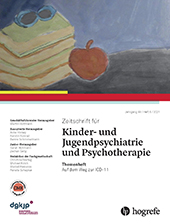Abstract
Zusammenfassung. Der Beitrag informiert über die Eingliederung der Suchtstörungen in die 11. Auflage der International Classification of Diseases (ICD-11) der Weltgesundheitsorganisation (WHO). Die Revision der ICD soll einem gewandelten Verständnis der Suchtstörungen und deren Diagnostik Rechnung tragen und die klinische Anwendbarkeit vereinfachen. Im Bereich der substanzbezogenen und nicht substanzbezogenen Störungen sind gegenüber der Vorgängerversion erhebliche Neuerungen eingeführt worden. Die wichtigsten Änderungen betreffen ein erweitertes Angebot an Stoffklassen, deutliche (vereinfachende) Anpassungen in den konzeptuellen und diagnostischen Leitlinien der substanzbezogenen Störungsbilder und insbesondere der „Abhängigkeit“, sowie die Einführung der Kategorie der „abhängigen Verhaltensweisen“ und damit verbunden die Zuordnung der „Glücksspielstörung“ zu den Suchtstörungen sowie die Aufnahme der neuen (bildschirmbezogenen) „Spielstörung“. Zudem findet eine Erweiterung der diagnostischen Optionen für frühe, präklinische Phänotypen der Suchtstörungen („Episodisch Schädlicher Gebrauch“) erstmals Eingang in den ICD-Katalog. Im vorliegenden Beitrag werden die Änderungen Episodisch schädlicher Gebrauch für den Bereich der Suchtstörungen aus kinder- und jugendpsychiatrischer Sicht zusammenfassend dargestellt und diskutiert.
Abstract. This paper concerns the revised classification of Substance-Related and Addictive Disorders in the 11th edition of the International Classification of Diseases (ICD-11) of the World Health Organization. The revision of the ICD serves to reflect changes in the understanding and diagnosis of addictive disorders and the need to improve clinical applicability. Regarding substance-related and non-substance-related addictive disorders, considerable innovations were introduced compared to the previous version. Major innovations include an expanded range of substance classes, significant adjustments (i. e., simplifications) in the conceptual and diagnostic guidelines of substance-related disorders, particularly “substance dependence”, the introduction of the category of “addictive behaviour,” and, associated with this, the assignment of “gambling disorder” to the addictive disorders, and the inclusion of the new (screen-related) “gaming disorder.” In addition, for the first time the ICD catalogue includes an expansion of diagnostic options for early, preclinical phenotypes of addiction disorders (“Episodic Harmful Use”). This article summarizes the changes in the field of addiction disorders and discusses them from a child and adolescent psychiatric perspective.
Literatur
(2017). Scholars’ open debate paper on the World Health Organization ICD-11 Gaming Disorder proposal. Journal of Behavioral Addictions, 6, 267–270.
(2013). The association between pathological Internet use and comorbid psychopathology: A systematic review. Psychopathology, 46, 1–13.
(2017). Greater prevalence of proposed ICD-11 alcohol and cannabis dependence compared to ICD-10, DSM-IV, and DSM-5 in treated adolescents. Alcohol Clinical and Experimental Research, 41, 1584–1592.
(2019). Concordance between the diagnostic guidelines for alcohol and cannabis use disorders in the draft ICD-11 and other classification systems: Analysis of data from the WHO’s World Mental Health Surveys. Addiction, 114, 534–552.
). (2018). Diagnostisches und Statistisches Manual Psychischer Störungen DSM-5 (2. korrigierte Aufl.). Göttingen: Hogrefe.
(2015). The development of the ICD-11 Clinical Descriptions and Diagnostic Guidelines for Mental and Behavioural Disorders. World Psychiatry, 14, 82–90.
(2013). DSM-5 criteria for substance use disorders: Recommendations and rationale. American Journal of Psychiatry, 170, 834–851.
(2014).
Die Grenzen des Suchtbegriffs . In K. Mann (Hrsg.) Verhaltenssüchte: Grundlagen, Diagnostik, Therapie, Prävention. Berlin, Heidelberg: Springer. 198–203(2014). DSM-5: wichtige Änderungen im Bereich der Suchterkrankungen. Nervenarzt, 85, 571–577.
(2018). ICD-11 – Anpassung der ICD an das 21. Jahrhundert. Bundesgesundheitsblatt, 61, 771–777.
(2016). Concordance of ICD-11 and DSM-5 definitions of alcohol and cannabis use disorders: a population survey. Lancet Psychiatry, 3, 673–684.
). (2014). Verhaltenssüchte: Grundlagen, Diagnostik, Therapie, Prävention (S. 11–31). Berlin: Springer.
(2016). Pathological gambling: A behavioral addiction. World Psychiatry, 15, 297–298.
(2010). Lifetime prevalence of mental disorders in U. S. adolescents: Results from the National Comorbidity Survey Replication-Adolescent Supplement (NCS-A). Journal of the American Academy of Child and Adolescent Psychiatry, 49, 980–989.
(2016). Global burden of diseases, injuries, and risk factors for young people’s health during 1990–2013: A systematic analysis for the Global Burden of Disease Study 2013. Lancet, 387, 2383–2401.
(2018). Aligning the ICD-11 classification of disorders due to substance use with global service needs. Epidemiology and Psychiatric Sciences, 27, 212–218.
(2017). Internet gaming disorder: Investigating the clinical relevance of a new phenomenon. American Journal of Psychiatry, 174, 230–236.
(2013). Computerspiel- und Internetsucht: Der aktuelle Forschungsstand. Nervenarzt, 84, 569–575.
(2017). Die Verhaltenssüchte in der ICD-11: Ein Update. Sucht, 63, 305–306.
(2011). Prävalenz der Internetabhängigkeit (PINTA): Bericht an das Bundesministerium für Gesundheit. Verfügbar unter http://www.fachportalsucht-nrw.de/tl_files/images/pages/PDFs/PINTA-Bericht-Endfassung_280611.pdf.
(2016). Prevention, early intervention, harm reduction, and treatment of substance use in young people. Lancet Psychiatry, 3, 280–296.
(2019). Alcohol use disorders in ICD-11: Past, present, and future. Alcohol Clinical and Experimental Research, 43, 1617–1631.
(2014). Substanzgebrauchsstörung und nicht-substanzgebundene Süchte im DSM-5. Zeitschrift für Kinder- und Jugendpsychiatrie und Psychotherapie, 42, 115–120.
) (2008). Suchtstörungen im Kindes- und Jugendalter. Das Handbuch: Grundlagen und Praxis. Stuttgart: Schattauer
(2017). The prevalence and psychosocial correlates of internet gaming disorder. Deutsches Ärzteblatt International, 114, 419–424.
(2011). Substance use disorders in DSM-V when applied to adolescents. Addiction, 106, 882–884.



